
Diary: The garden in June 2000

 | Diary: The garden in June 2000 |

|
June 1st and with a "garden gale" following rain many of the plants are being battered to the ground. The trees, with full canopies of leaves caught in the stronger gusts, are being bent and tested in the southwesterly wind. Some leaves, shredded and torn from the branches, are forming small heaps on the ground. Some leafy twigs broke off and litter the grassy areas. Despite the wind the mistle thrushes are singing in the treetops not minding the wind and rain. During the morning young blue tits raised in one of our new boxes decided to leave the nest. What a day for them to leave the safety of the nest box! One by one they emerged and we could hear them calling in the sycamore tree nearby. The last one seemed very reluctant to leave, but eventually did so. The family kept fairly close together during the day and seemed to be able to cope with the weather.  Although the wind only reached force 7, not quite a gale in meteorological terms, to the gardener it is a gale. And a gale with rain is bad news as the plants heavy with surface water are more vulnerable to the heavy gusts. The most affected parts of the garden are near the southerly corners of the house, here the wind eddies and speeds-up creating a narrow strip where it is difficult to grow some plants. Some dwarf conifers are affected, with these the damage is done on their lee side, away from the wind.
Although the wind only reached force 7, not quite a gale in meteorological terms, to the gardener it is a gale. And a gale with rain is bad news as the plants heavy with surface water are more vulnerable to the heavy gusts. The most affected parts of the garden are near the southerly corners of the house, here the wind eddies and speeds-up creating a narrow strip where it is difficult to grow some plants. Some dwarf conifers are affected, with these the damage is done on their lee side, away from the wind. 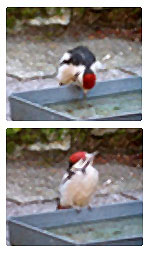 Looking from the southwest they seem perfect, from the northeast they are quite badly browned and do not regrow. The herbaceous border is, in comparison, fairly sheltered and damage was minimal. Just one or two spikes of the colourful lupins were broken off and the foxgloves, just starting to bloom, could be spoiled. Both the lupins and foxgloves are grown from seed and planted out in the autumn. The lupins will perhaps grow on for 2 or 3 years but then need to be replaced. The foxgloves are biennial; it is a pity to see them spoiled after the hard work of raising the plants. We have plenty of self-sown wild foxgloves Digitalis spp, these pop up in unusual places, especially on the rocky outcrops.
Looking from the southwest they seem perfect, from the northeast they are quite badly browned and do not regrow. The herbaceous border is, in comparison, fairly sheltered and damage was minimal. Just one or two spikes of the colourful lupins were broken off and the foxgloves, just starting to bloom, could be spoiled. Both the lupins and foxgloves are grown from seed and planted out in the autumn. The lupins will perhaps grow on for 2 or 3 years but then need to be replaced. The foxgloves are biennial; it is a pity to see them spoiled after the hard work of raising the plants. We have plenty of self-sown wild foxgloves Digitalis spp, these pop up in unusual places, especially on the rocky outcrops.
The dull and wet weather continued on the 2-3rd so that little work was done in the garden. The wind has lessened and the mistle thrushes continue singing loudly from the treetops. The blackcaps are occasionally singing, but these seem to enjoy sunnier weather. There are a lot of fledged blue tits flying about. Those have joined the ones from the new box from an old wooden box in view from our kitchen window. They are quite noisy as they call to their parents for food. They are paler and have yellow cheeks, not white as have the adult birds. There are also young great tits and nuthatches around the garden. They are still grouped together as families and are brought near to the feeding stations by the adults. As yet the youngsters do not approach the food, the adults take it to them in the nearby trees and bushes. With so many families in the garden it is a wonder they do not get mixed up, perhaps they do! The great spotted woodpeckers have started to bring their young to be fed at the peanut feeders. For some days adult birds have been taking pieces of peanut to feed young birds up in the trees. Now the young are confident enough to come close to the feeders. The youngster will wait for the adult, usually the male, to get the nuts and feed it. In a few days the young bird joins the male on the feeder. It will be a few days more before it gets the hang of extracting bits of the nuts for itself. At this stage the young bird will let nuthatches and tits drive it off. It will soon learn that all others will give way to a woodpecker. One of the young woodpeckers went to look at one of the water trays. It tried to bathe, but was unsuccessful as it stood outside the tray of water flapping its wings and it did not get wet. By the time I had got the camera it had stopped trying, but I caught it drinking. It is easy to spot any species of fledgling birds on the wing; they are still refining their flying techniques. They are also vulnerable to flying into windows. We hang card cut outs resembling predators on the glass, this seems to give some warning but there are sometimes accidents. 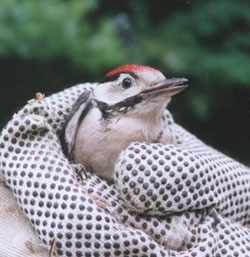 A young woodpecker once failed to see the warning and flew into the glass. It was stunned but after a little time recovered and flew away. I like to think it could be one of this years' adults bringing its offspring to feed. The 4th was a dry day and the sun did appear from time to time. The lawn grass had dried by the afternoon so opportunity was taken to do some mowing. Inspection of the vegetable plot showed that the lettuces had grown well and the peas and beans were looking good. The potatoes emerged from their earthed up rows about a week ago and have already put on several leaves. The soil is moist and at this time of year quite warm so that rapid growth can now be expected in all the crops. There is still space on the plot reserved for later sowings of purple sprouting broccoli and sea kale. These are again being brought on from seed sown in the greenhouse in modules. There will be room for some more lettuce. Around the flower borders the Welsh poppies are still producing flowers although the seed heads are forming on many of the earlier blooms. A few yellow flowered plants have popped up here and there from the seed we have scattered in the past. The yellow ones do not seem to be so prolific as the orange. We have tried several times to establish a yellow flowered population. In the damp border the candelabra primulas are coming into flower, these are interesting because they continue to produce whorls of flowers up an increasingly long stem. We often have 5-8 whorls of flowers over the season. Also coming into flower is the rare Silene officinalis, the seeds of which we were provided with many years ago to maintain a stock of the plant. It is a perennial, but the plants seem to become moribund and die off after a few years. New plants spring up from self-sown seed and can be transplanted to fresh ground in the garden when necessary.
A young woodpecker once failed to see the warning and flew into the glass. It was stunned but after a little time recovered and flew away. I like to think it could be one of this years' adults bringing its offspring to feed. The 4th was a dry day and the sun did appear from time to time. The lawn grass had dried by the afternoon so opportunity was taken to do some mowing. Inspection of the vegetable plot showed that the lettuces had grown well and the peas and beans were looking good. The potatoes emerged from their earthed up rows about a week ago and have already put on several leaves. The soil is moist and at this time of year quite warm so that rapid growth can now be expected in all the crops. There is still space on the plot reserved for later sowings of purple sprouting broccoli and sea kale. These are again being brought on from seed sown in the greenhouse in modules. There will be room for some more lettuce. Around the flower borders the Welsh poppies are still producing flowers although the seed heads are forming on many of the earlier blooms. A few yellow flowered plants have popped up here and there from the seed we have scattered in the past. The yellow ones do not seem to be so prolific as the orange. We have tried several times to establish a yellow flowered population. In the damp border the candelabra primulas are coming into flower, these are interesting because they continue to produce whorls of flowers up an increasingly long stem. We often have 5-8 whorls of flowers over the season. Also coming into flower is the rare Silene officinalis, the seeds of which we were provided with many years ago to maintain a stock of the plant. It is a perennial, but the plants seem to become moribund and die off after a few years. New plants spring up from self-sown seed and can be transplanted to fresh ground in the garden when necessary.
With the long summer days the birds have the garden to themselves for many of the daylight hours. On the 6th the mistle thrushes, that still dominate the chorus, began singing a few minutes before 4 am. The song thrushes, blackbirds, blackcaps and robins soon join them. It is the best time to hear the birdsong, as the countryside is still quiet. It is too early for traffic noise, as people make their way to work, and the farm vehicles are as yet unused. It is also too early for flights from RAF Valley to have started although occasionally the rescue helicopter has an early call out. On really quiet mornings, with the wind in the south, it is sometimes possible to hear a train on the Holyhead to London railway line, as it passes between the Britannia Bridge and the tunnel entering Bangor. This morning there were none of these and the birdsong was uninterrupted. The mistle thrush will sing sometimes in spells of at least 3 hours. He has short breaks when he looks for food then returns to sing once more. The thrushes do not need to forage for food all day, as do the smaller birds, especially the tits and wrens. Being able to catch and consume larger prey, such as a snail, gives them more time for singing.  After a mixed day of a little sunshine and showers the sky cleared in the evening and it was sunny. After sunset the sky was still quite light and the mistle thrush finally stopped singing at 10 minutes past 10pm. By the 7th there has been a change in the occupation of the airspace over the garden. Gone are the rooks having raised their young in the nearby rookeries, off to distant fields where they can be seen, a hundred or so hunting for food. In their place are the chattering house martins and swallows. Spectacular fliers around the treetops, or sometimes lower around the garden, catching the profusion of insects that are now available on the wing. Most nesting sites are just up the road in and on old farm buildings and near neighbours have had swallows nesting in their garden shed. We have often wondered why they did not nest here. There was therefore great excitement when a pair of house martins was seen flying up to the south gable. A look outside revealed that they were putting mud on the wall at the highest point under the overhang. We thought it a little late in the season to start building a new nest, but they persisted most of the day. In succeeding days not much progress was made. Some days we did not see them at all, then they would return and put up some more mud.
After a mixed day of a little sunshine and showers the sky cleared in the evening and it was sunny. After sunset the sky was still quite light and the mistle thrush finally stopped singing at 10 minutes past 10pm. By the 7th there has been a change in the occupation of the airspace over the garden. Gone are the rooks having raised their young in the nearby rookeries, off to distant fields where they can be seen, a hundred or so hunting for food. In their place are the chattering house martins and swallows. Spectacular fliers around the treetops, or sometimes lower around the garden, catching the profusion of insects that are now available on the wing. Most nesting sites are just up the road in and on old farm buildings and near neighbours have had swallows nesting in their garden shed. We have often wondered why they did not nest here. There was therefore great excitement when a pair of house martins was seen flying up to the south gable. A look outside revealed that they were putting mud on the wall at the highest point under the overhang. We thought it a little late in the season to start building a new nest, but they persisted most of the day. In succeeding days not much progress was made. Some days we did not see them at all, then they would return and put up some more mud.
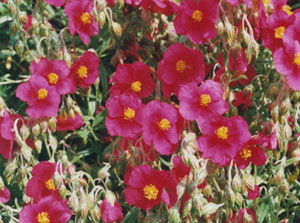
The runner beans, raised from seed sown in the greenhouse, have been hardening off in the cold frame and are ready for planting out on the 10th. The 8ft tall bamboo canes have been waiting, set up some days before, in a double line on the vegetable plot. Bent towards the middle of the double row they are tied with a self-tightening knot to horizontal canes with a continuous length of polythene string. The beans are put along one edge of the vegetable plot at the top of the slope facing almost south and do not obscure the light from other crops. They are alternated each year with the row of sweet peas. In this way we have found that soil fertility is maintained, the beans fix and accumulate nitrogen in tubers in the soil.Disease is also minimised by this method. The current position of the row is fairly new; it used to be on the lower plot near the greenhouse now transformed into the new flower border. The beans were planted out and, as it was a windy day, it was necessary to tie some of them in to the poles. This is normally unnecessary, as they are self-climbing, twining themselves up the poles in an anti-clockwise direction. Also planted out, next to 2 rows of shallots, was a row of sea kale beet (Fordhook Giant) raised in modules. This is a very useful vegetable as the leaves can be taken on a cut and come again basis. It will continue producing new leaves well into the autumn, and after standing the winter produce a flush of leaves giving an early crop in the spring. The last of the rhododendrons in the garden, an orange flowered deciduous type, has just about finished. We have had rhododendron flowers continuously on different varieties since the middle of March. After flowering they look untidy for a while but already some are producing new fresh looking leaves. There are still flowers on some of the naturalised Rhododendron ponticum in the wood and along the shelterbelts bordering nearby fields. Another "garden gale" on the 12th as winds circulated around an unusually low depression to the northwest of Scotland. Winds here were gusting to gale force during the afternoon and into the night. The wind eased next day and a damage inspection revealed that many of the runner beans had been untwined and had to be retied. A few sweet peas, with broken tendrils, had been dislodged from their wire supports and also had to be tied back. The chrysanthemums, recently tied in to their canes, survived without damage. Some of the roses are flowering well, especially the Zephirene Drouhin, and were little damaged by the wind. In the heather borders Erica cinerea is beginning to come into flower. In contrast to other Ericas in the garden this looks almost dead during the winter. Now it has come to life and is the only variety in flower at the moment, but there will be others later on.
A few sweet peas, with broken tendrils, had been dislodged from their wire supports and also had to be tied back. The chrysanthemums, recently tied in to their canes, survived without damage. Some of the roses are flowering well, especially the Zephirene Drouhin, and were little damaged by the wind. In the heather borders Erica cinerea is beginning to come into flower. In contrast to other Ericas in the garden this looks almost dead during the winter. Now it has come to life and is the only variety in flower at the moment, but there will be others later on. 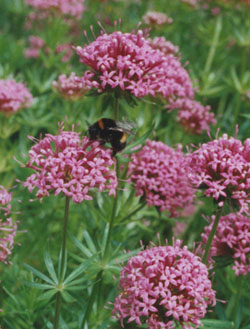 On the 14th a female sparrowhawk made an attack on 2 woodpeckers at the peanut feeder under the conifer near the house. Although the attack was, as usual, very sudden both birds were quicker and flew to safety. This is the first attack on woodpeckers we have seen, usually it is on collared doves and, being much slower off the mark and in flight, are usually caught. The sparrowhawk was still around on the 17th and was seen twice being driven off by a flock of swallows and house martins. Also around is a pair of ravens, with their distinctive deep croaking calls, sometimes perching in tall Scots pine trees across the road near the house. In the evening, while still quite light, a tawny owl was being noisily mobbed by blackbirds.
On the 14th a female sparrowhawk made an attack on 2 woodpeckers at the peanut feeder under the conifer near the house. Although the attack was, as usual, very sudden both birds were quicker and flew to safety. This is the first attack on woodpeckers we have seen, usually it is on collared doves and, being much slower off the mark and in flight, are usually caught. The sparrowhawk was still around on the 17th and was seen twice being driven off by a flock of swallows and house martins. Also around is a pair of ravens, with their distinctive deep croaking calls, sometimes perching in tall Scots pine trees across the road near the house. In the evening, while still quite light, a tawny owl was being noisily mobbed by blackbirds.
The 18th was a really warm still day. From early it felt warm and the garden was buzzing with insects. On the rockery banks large patches of orange and red rock-roses were in full bloom, as were the prostrate white and larger pink coloured Cistus. Before 8am these were covered by bees, both small bumblebees and honeybees taking advantage of the pollen and nectar before the flowers dropped later in the day. Both flowers are of the 'flower for a day type'. Each day, for several weeks masses of new flowers are produced and then the petals drop by the afternoon. Fallen petals on rock-roses are not very obvious but the larger Cistus petals are easily seen scattered on the soil. A French rock-rose Halimiocistus, a hybrid between Cistus and Halimium spp, edging the border dropped its white petals on the lawn. This is the nearest effect we have of the Cistus that EVB referred to in her garden in January 1883 at Huntercombe Manor. The rock-roses seem tolerant of wind (and said to be of salt also) but the larger Cistus are vulnerable, their woody stems tending to break in strong winds. Another favourite of the bees is Phuopsis stylosa that is a mass of pink flowers. This is the plant which, after dying back in the winter, is gathered by mistle thrushes in the spring for nesting material (see 12th February). 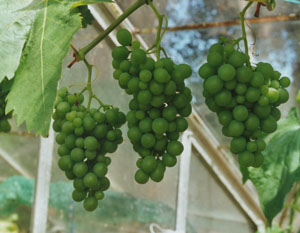 At dusk on the evening of the 20th tens of brown medium size moths were gathered on flowers on sage bushes in the garden. The sage is now in full flower and, during the day, looks very spectacular. Obviously it is also a big attraction to moths at dusk. They gathered on the sage bushes for several nights when the weather was warm and still. There were some bats flying about between the trees but disappointingly like last year, after a short while in residence in the house, they left again. I would really like to know where their other roosts are located.
At dusk on the evening of the 20th tens of brown medium size moths were gathered on flowers on sage bushes in the garden. The sage is now in full flower and, during the day, looks very spectacular. Obviously it is also a big attraction to moths at dusk. They gathered on the sage bushes for several nights when the weather was warm and still. There were some bats flying about between the trees but disappointingly like last year, after a short while in residence in the house, they left again. I would really like to know where their other roosts are located. 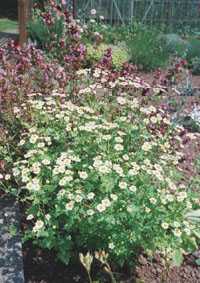 In the greenhouse on the 27th there were good trusses of tomatoes on all of the plants. In previous years I have had problems with bud drop on the first trusses leading to loss of early ripe tomatoes. I put this down to the occasional drop in temperature on a clear night following a warm day, a similar thing happens to sweet peas in the garden. As the greenhouse is constructed of aluminium, good for strength and long-life, the temperature drop is enhanced. It does not seem to happen as much in wooden greenhouses. I have got over this problem by running the electrical heater, with the thermostat set at 12C, well into summer to catch these few occasions. Normally the heater does not come on and the fan just circulates the air helping to minimise attacks of Botrytis and other diseases. The hot chilli pepper plants (Hot Mexican), an essential constituent in stir-fries and chutney made in the autumn, are now about 0.5m tall in their 15cm pots and are covered in flowers. The cucumbers, an all-female F1 variety Diana we are trying for the first time, are doing well and producing the first small cucumbers. I grow these on the bench in 30cm diameter builders-type black buckets in a 50:50 mixture of John Innes No 3 potting compost and an organic based compost. The still green grapes on the Black Hamburg are swelling up nicely. Some further pruning back of non fruit-bearing shoots was necessary. I counted about 40 good-sized bunches along the length of the vine. Around the garden there are plants of the aromatic herb feverfew Tanacetum (Chrysanthemum) parthenium. The whole plant has a strong scent and the taste is very bitter. Probably introduced it occurs widely but is encouraged in cottage gardens. It seeds itself and plants pop up from time to time in the flower border or vegetable plot. We make sure we have several plants, they are not always where we would like them to be; they grow best where they appear but they can be transplanted when small. It has been used in the past as a medicinal herb. The 17th century Culpeper's Complete Herbal lists many of its uses including a 'general strenghtener for women' and ' to make use of her herb boiled in white wine... it cleanses the womb'. Its use 'for all pains in the head' still has its followers, as many today find it gives relief for migraine. It is also said to give help for aches and pains of the back; I must admit to taking the odd leaf as I pass one of the plants!
In the greenhouse on the 27th there were good trusses of tomatoes on all of the plants. In previous years I have had problems with bud drop on the first trusses leading to loss of early ripe tomatoes. I put this down to the occasional drop in temperature on a clear night following a warm day, a similar thing happens to sweet peas in the garden. As the greenhouse is constructed of aluminium, good for strength and long-life, the temperature drop is enhanced. It does not seem to happen as much in wooden greenhouses. I have got over this problem by running the electrical heater, with the thermostat set at 12C, well into summer to catch these few occasions. Normally the heater does not come on and the fan just circulates the air helping to minimise attacks of Botrytis and other diseases. The hot chilli pepper plants (Hot Mexican), an essential constituent in stir-fries and chutney made in the autumn, are now about 0.5m tall in their 15cm pots and are covered in flowers. The cucumbers, an all-female F1 variety Diana we are trying for the first time, are doing well and producing the first small cucumbers. I grow these on the bench in 30cm diameter builders-type black buckets in a 50:50 mixture of John Innes No 3 potting compost and an organic based compost. The still green grapes on the Black Hamburg are swelling up nicely. Some further pruning back of non fruit-bearing shoots was necessary. I counted about 40 good-sized bunches along the length of the vine. Around the garden there are plants of the aromatic herb feverfew Tanacetum (Chrysanthemum) parthenium. The whole plant has a strong scent and the taste is very bitter. Probably introduced it occurs widely but is encouraged in cottage gardens. It seeds itself and plants pop up from time to time in the flower border or vegetable plot. We make sure we have several plants, they are not always where we would like them to be; they grow best where they appear but they can be transplanted when small. It has been used in the past as a medicinal herb. The 17th century Culpeper's Complete Herbal lists many of its uses including a 'general strenghtener for women' and ' to make use of her herb boiled in white wine... it cleanses the womb'. Its use 'for all pains in the head' still has its followers, as many today find it gives relief for migraine. It is also said to give help for aches and pains of the back; I must admit to taking the odd leaf as I pass one of the plants!
Document dated: 30 June 2000. This page is part of the site maintained at http://www.llansadwrn-wx.co.uk
Copyright ©: 2000 Donald and Patricia Perkins